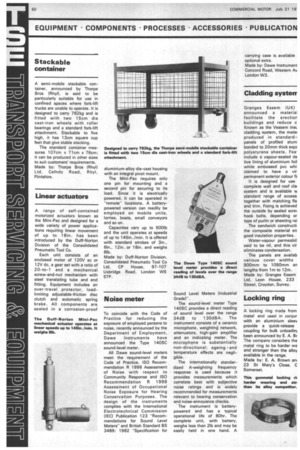N oise meter
Page 52

If you've noticed an error in this article please click here to report it so we can fix it.
To coincide with the Code of Practice for reducing the exposure of employed persons to noise, recently announced by the Department of Employment, Dawe Instruments have announced the Type 1405C sound-level meter.
All Dawe sound-level meters meet the requirement of the Code of Practice, ISO Recommendation R 1996 Assessment of Noise with respect to Community Response and ISO Recommendation R 1999 Assessment of Occupational Noise Exposure for Hearing Conservation Purposes. The design of the instruments complies with the International Electrotechnical Commission (IEC) Publication 123 "Recommendations for Sound Level Meters" and British Standard BS 3489: 1962 "Specification for Sound Level Meters (Industrial Grader.
The sound-level meter Type 1405C provides a direct reading of sound level over the range 34(1B to 130dBA. The instrument consists of a ceramic microphone, weighting network, attenuators, high-gain amplifier and an indicating meter. The microphone is substantially non-directional; ageing • and temperature effects are negligible.
The internationally standardized A-weighting frequency response is used because it provides measurements which correlate best with subjective noise ratings and is widely recommended for measurements relevant to hearing conservation and noise-annoyance checks.
The instrument is batterypowered and has a typical operational life of 80hr. The complete unit, with battery, weighs less than 2Ib and may be easily held in one hand. A carrying case is available optional extra.
Made by: Dawe Instrument Concord Road, Western AN/ London W3.




























































































